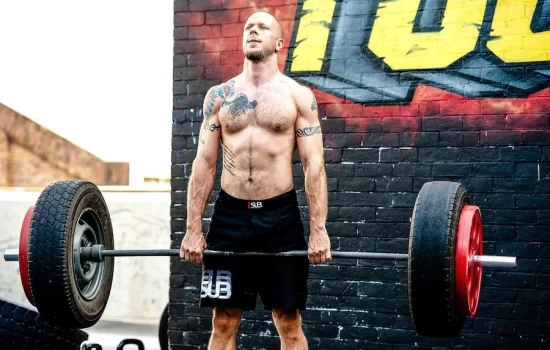Table of Contents
- What Actually is the 5 5 5 30 Workout? (And Why You Should Care)
- The Beginner-Friendly Morning Routine (That Actually Works!)
- The Advanced 5 5 5 30 Method: For When You’re Ready to Level Up
- Advanced Programming Strategies
- Recovery and Nutrition Considerations
- Common Mistakes to Avoid
- Modifications and Progressions
- Tracking Progress
- Final Tips for Success
- Common Questions I Get Asked
- The Bottom Line
Look, I get it – when I first heard about the 5 5 5 30 workout routine, I was skeptical. Another fitness trend? Really? But after diving deep into this workout method and trying it myself, I’ve got to tell you – this is something special, especially if you’re struggling to find time for exercise (like I was back in the day).
What Actually is the 5 5 5 30 Workout? (And Why You Should Care)
Here’s the thing that surprised me – there isn’t just one 5 5 5 30 workout routine. Through my research and personal experience, I’ve discovered there are two different approaches: one that’s perfect for everyday fitness enthusiasts (like me when I started), and another for those serious gym-goers who want to level up their game.
The Beginner-Friendly Morning Routine (That Actually Works!)

Remember those mornings when you wanted to work out but felt overwhelmed about where to start? Yeah, been there. That’s exactly why I fell in love with the first version of the 5 5 5 30 routine. It’s straightforward, yet effective.
The Basic Breakdown (No Fancy Equipment Needed):
- 5 Pushups
- 5 Squats
- 5 Lunges
- 30-Second Plank
Let’s break these down, and I’ll share some personal insights about each exercise.

1. Mastering Those 5 Pushups
Personal Note: I could barely do 3 proper pushups when I started. Don’t worry if you’re in the same boat!
Pushups are like the Swiss Army knife of exercises – they work:
- Your chest muscles (pectoralis major and minor)
- Triceps
- Shoulders
- Core stability
Is 5 Really Enough?
Here’s my honest take: Five pushups alone won’t transform your upper body. But here’s the secret I learned: it’s about consistency and progression. Start with five, then gradually push yourself to do more or try harder variations. I started adding one extra pushup each week, and the progress was incredible.
2. The 5 Squats That Changed My Lower Body Game
Quick Tip: I always tell my friends – if you’re not feeling these in your thighs, you’re probably not going deep enough!
Benefits I’ve personally experienced:
- Stronger legs (goodbye, wobbly knees!)
- Better core stability
- Improved balance
- Enhanced lower body flexibility
3. Those 5 Game-Changing Lunges
Let me tell you something funny – I used to hate lunges with a passion. But now? They’re my secret weapon for:
- Building leg strength
- Improving balance (trust me, you’ll notice the difference)
- Working those glutes
- Enhancing overall stability
4. The 30-Second Plank Challenge
Personal Confession: My first 30-second plank felt like an eternity!
This is where the magic happens. The plank works:
- Your entire core
- Shoulder stability
- Back Strength
- Mental toughness (seriously!)
The Advanced 5 5 5 30 Method: For When You’re Ready to Level Up

Let me be honest – when I first transitioned from the basic 5-5-5-30 to this advanced method, I was completely overwhelmed. But after months of practice and refinement, I’ve discovered this is one of the most effective training protocols I’ve ever used. Let me break down exactly how it works and share some personal insights that made a huge difference in my training.
The Advanced Breakdown:
Phase 1: 5 Sets of 5 Reps (The Strength Builder)
- Use challenging weights
- Focus on perfect form
- Rest between sets is crucial
Phase 2: 5 Sets of 10 Reps (The Muscle Builder)
- Slightly lighter weights
- Concentrate on the mind-muscle connection
- Perfect for hypertrophy
Phase 3: 5 Sets of 15 Reps (The Endurance Phase)
- Lighter weights
- Higher rep range
- Burns like crazy (in a good way!)
Phase 4: 30-Second Rest Periods
- Just enough to catch your breath
- Maintains workout intensity
- Keeps your heart rate up
Phase 1: 5 Sets of 5 Reps (The Strength Builder)
From personal experience: This is where you’ll build your foundational strength. I remember being tempted to go lighter – don’t make that mistake!
Weight Selection
- Use 80-85% of your 1RM (one-rep maximum)
- The weight should be heavy enough that reps 4-5 feel challenging
- You should be able to maintain proper form for all reps
Example Exercise Selection:
Compound Movements Work Best:
- Barbell Squats
- Bench Press
- Deadlifts
- Military Press
- Bent-Over Rows
Key Points to remember:
- Focus on explosive concentric movement (lifting phase)
- Control the eccentric phase (lowering)
- Rest exactly 30 seconds between sets
- Track your weights to ensure progressive overload
Phase 2: Hypertrophy Focus (5 Sets of 10 Reps)
Personal Note: This is where the real muscle-building magic happens. Your muscles should be pumped, but not completely fatigued.
Weight Selection:
- Use 65-75% of your 1RM
- Weight should allow all 10 reps with good form
- Last 2-3 reps should be challenging
Exercise Selection Examples:
- Upper Body:
- Incline Dumbbell Press
- Cable Rows
- Lateral Raises
- Bicep Curls
- Tricep Extensions
- Lower Body:
- Leg Press
- Romanian Deadlifts
- Leg Extensions
- Calf Raises
- Hip Thrusts
Key Points to remember:
- Focus on time under tension
- Control both concentric and eccentric phases
- Maintain mind-muscle connection
- Strict 30-second rest periods
Phase 3: Endurance Focus (5 Sets of 15 Reps)
Personal Confession: This phase humbled me the most. The burn is real, but the results are worth it!
Weight Selection:
- Use 50-60% of your 1RM
- Choose a weight you could lift for 20 reps if pushed
- Form must remain perfect even when fatigued
Exercise Selection Examples:
- Isolation Movements Work Great Here:
- Cable Flyes
- Face Pulls
- Leg Extensions
- Lateral Raises
- Rope Pushdowns
Key Points to remember:
- Focus on maintaining form despite fatigue
- Keep rest periods strict at 30 seconds
- Breathing becomes crucial
- Mental toughness is as important as physical strength
Advanced Programming Strategies
Weekly Split Example:
This is the split that worked best for me after trying several variations:
| Monday | Tuesday | Wednesday | Thursday | Friday |
|---|---|---|---|---|
| Focus on the Chest & Triceps | Focus on the Back & Biceps | Rest | Focus on Legs | Focus on Shoulders & Arms |
| Phase 1: Bench Press | Phase 1: Bent-Over Rows | – | Phase 1: Squats | Phase 1: Military Press |
| Phase 2: Incline Dumbbell Press | Phase 2: Lat Pulldowns | – | Phase 2: Romanian Deadlifts | Phase 2: Lateral Raises |
| Phase 3: Cable Flyes | Phase 3: Face Pulls | – | Phase 3: Leg Extensions | Phase 3: Rear Delt Flyes |
Progressive Overload Strategies:
1. Weight Progression:
- Increase Phase 1 weights by 2.5-5% when all sets are completed
- Add 5% to Phase 2 when you can complete all sets with perfect form
- Progress Phase 3 weights only when endurance improves significantly
2. Form Progression:
- Start with basic variations
- Add complexity as strength improves
- Consider advanced variations for main lifts
Recovery and Nutrition Considerations
Rest Periods:
- 30 seconds between sets is crucial
- 48 hours between training same muscle groups
- One full rest day per week minimum
Nutrition Requirements:
- Higher protein intake (1.6-2.0g per kg bodyweight)
- Adequate carbs for energy (especially pre-workout)
- Essential fats for hormone optimization
Common Mistakes to Avoid
I learned these the hard way, so you don’t have to:
- Starting Too Heavy
- Begin conservative and progress steadily
- Form over weight always
- Rushing Between Phases
- Complete all sets before moving to next phase
- Maintain strict rest periods
- Neglecting Recovery
- Sleep becomes crucial
- Nutrition timing matters
- Listen to your body’s signals
Modifications and Progressions
For Intermediate Lifters:
- Start with 3 sets instead of 5
- Use slightly lighter weights
- Focus on form mastery
For Advanced Lifters:
- Add dropsets to Phase 3
- Incorporate pause reps in Phase 1
- Experiment with tempo manipulation
Tracking Progress
Keep detailed records of:
- Weights used for each phase
- Quality of reps performed
- Recovery between sessions
- Energy levels during workouts
Final Tips for Success
- Start with a deload week if coming from another program
- Film your form regularly
- Adjust weights based on daily energy levels
- Stay hydrated throughout all phases
- Consider pre-workout nutrition timing
- Be patient with progress
Remember, this advanced method is intense and requires dedication. Don’t be afraid to scale back if needed – it’s better to progress slowly than to burn out quickly.
Common Questions I Get Asked
While you could do the beginner version daily, I recommend starting with 3-4 times a week and seeing how your body responds.
From my experience, you’ll feel different in 2 weeks and see changes in 4-6 weeks. But remember, everyone’s journey is different!
Absolutely! I often use this as my morning routine and do other workouts later in the day.
The Bottom Line
The 5 5 5 30 workout isn’t just another fitness trend – it’s a versatile, effective approach that can work for almost anyone. Whether you’re just starting or looking to level up your fitness game, this routine has something to offer.
Remember, fitness isn’t about perfection – it’s about progress. Start where you are, be consistent, and watch how this simple routine can transform not just your body, but your entire day.
It’s your turn now—give it a try and let me know how it goes! Please comment below with your experience or any questions you might have.
Hope you liked this article. Checkout Fitness for more such informative article.
Related article














